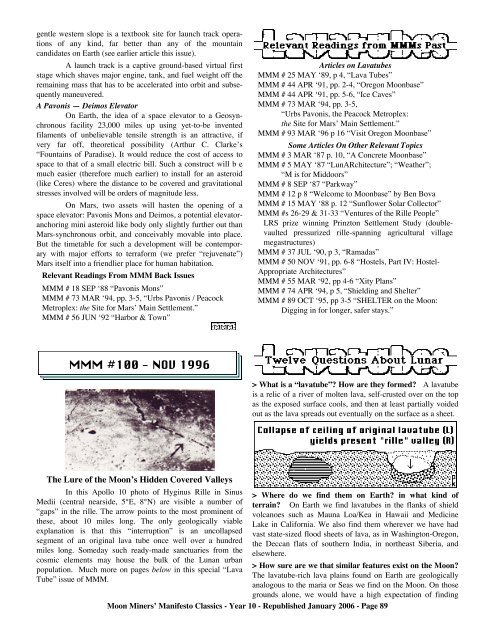MMM Classics Year 10: MMM #s 91-100 - Moon Society
MMM Classics Year 10: MMM #s 91-100 - Moon Society
MMM Classics Year 10: MMM #s 91-100 - Moon Society
You also want an ePaper? Increase the reach of your titles
YUMPU automatically turns print PDFs into web optimized ePapers that Google loves.
gentle western slope is a textbook site for launch track operations<br />
of any kind, far better than any of the mountain<br />
candidates on Earth (see earlier article this issue).<br />
A launch track is a captive ground-based virtual first<br />
stage which shaves major engine, tank, and fuel weight off the<br />
remaining mass that has to be accelerated into orbit and subsequently<br />
maneuvered.<br />
A Pavonis — Deimos Elevator<br />
On Earth, the idea of a space elevator to a Geosynchronous<br />
facility 23,000 miles up using yet-to-be invented<br />
filaments of unbelievable tensile strength is an attractive, if<br />
very far off, theoretical possibility (Arthur C. Clarke’s<br />
“Fountains of Paradise). It would reduce the cost of access to<br />
space to that of a small electric bill. Such a construct will b e<br />
much easier (therefore much earlier) to install for an asteroid<br />
(like Ceres) where the distance to be covered and gravitational<br />
stresses involved will be orders of magnitude less.<br />
On Mars, two assets will hasten the opening of a<br />
space elevator: Pavonis Mons and Deimos, a potential elevatoranchoring<br />
mini asteroid like body only slightly further out than<br />
Mars-synchronous orbit, and conceivably movable into place.<br />
But the timetable for such a development will be contemporary<br />
with major efforts to terraform (we prefer “rejuvenate”)<br />
Mars itself into a friendlier place for human habitation.<br />
Relevant Readings From <strong>MMM</strong> Back Issues<br />
<strong>MMM</strong> # 18 SEP ‘88 “Pavonis Mons”<br />
<strong>MMM</strong> # 73 MAR ‘94, pp. 3-5, “Urbs Pavonis / Peacock<br />
Metroplex: the Site for Mars’ Main Settlement.”<br />
<strong>MMM</strong> # 56 JUN ‘92 “Harbor & Town”<br />
<strong>MMM</strong> #<strong>10</strong>0 - NOV 1996<br />
The Lure of the <strong>Moon</strong>’s Hidden Covered Valleys<br />
In this Apollo <strong>10</strong> photo of Hyginus Rille in Sinus<br />
Medii (central nearside, 5°E, 8°N) are visible a number of<br />
“gaps” in the rille. The arrow points to the most prominent of<br />
these, about <strong>10</strong> miles long. The only geologically viable<br />
explanation is that this “interruption” is an uncollapsed<br />
segment of an original lava tube once well over a hundred<br />
miles long. Someday such ready-made sanctuaries from the<br />
cosmic elements may house the bulk of the Lunan urban<br />
population. Much more on pages below in this special “Lava<br />
Tube” issue of <strong>MMM</strong>.<br />
Articles on Lavatubes<br />
<strong>MMM</strong> # 25 MAY ‘89, p 4, “Lava Tubes”<br />
<strong>MMM</strong> # 44 APR ‘<strong>91</strong>, pp. 2-4, “Oregon <strong>Moon</strong>base”<br />
<strong>MMM</strong> # 44 APR ‘<strong>91</strong>, pp. 5-6, “Ice Caves”<br />
<strong>MMM</strong> # 73 MAR ‘94, pp. 3-5,<br />
“Urbs Pavonis, the Peacock Metroplex:<br />
the Site for Mars’ Main Settlement.”<br />
<strong>MMM</strong> # 93 MAR ‘96 p 16 “Visit Oregon <strong>Moon</strong>base”<br />
Some Articles On Other Relevant Topics<br />
<strong>MMM</strong> # 3 MAR ‘87 p. <strong>10</strong>, “A Concrete <strong>Moon</strong>base”<br />
<strong>MMM</strong> # 5 MAY ‘87 “LunARchitecture”; “Weather”;<br />
“M is for Middoors”<br />
<strong>MMM</strong> # 8 SEP ‘87 “Parkway”<br />
<strong>MMM</strong> # 12 p 8 “Welcome to <strong>Moon</strong>base” by Ben Bova<br />
<strong>MMM</strong> # 15 MAY ‘88 p. 12 “Sunflower Solar Collector”<br />
<strong>MMM</strong> <strong>#s</strong> 26-29 & 31-33 “Ventures of the Rille People”<br />
LRS prize winning Prinzton Settlement Study (doublevaulted<br />
pressurized rille-spanning agricultural village<br />
megastructures)<br />
<strong>MMM</strong> # 37 JUL ‘90, p 3, “Ramadas”<br />
<strong>MMM</strong> # 50 NOV ‘<strong>91</strong>, pp. 6-8 “Hostels, Part IV: Hostel-<br />
Appropriate Architectures”<br />
<strong>MMM</strong> # 55 MAR ‘92, pp 4-6 “Xity Plans”<br />
<strong>MMM</strong> # 74 APR ‘94, p 5, “Shielding and Shelter”<br />
<strong>MMM</strong> # 89 OCT ‘95, pp 3-5 “SHELTER on the <strong>Moon</strong>:<br />
Digging in for longer, safer stays.”<br />
> What is a “lavatube”? How are they formed? A lavatube<br />
is a relic of a river of molten lava, self-crusted over on the top<br />
as the exposed surface cools, and then at least partially voided<br />
out as the lava spreads out eventually on the surface as a sheet.<br />
> Where do we find them on Earth? in what kind of<br />
terrain? On Earth we find lavatubes in the flanks of shield<br />
volcanoes such as Mauna Loa/Kea in Hawaii and Medicine<br />
Lake in California. We also find them wherever we have had<br />
vast state-sized flood sheets of lava, as in Washington-Oregon,<br />
the Deccan flats of southern India, in northeast Siberia, and<br />
elsewhere.<br />
> How sure are we that similar features exist on the <strong>Moon</strong>?<br />
The lavatube-rich lava plains found on Earth are geologically<br />
analogous to the maria or Seas we find on the <strong>Moon</strong>. On those<br />
grounds alone, we would have a high expectation of finding<br />
<strong>Moon</strong> Miners’ Manifesto <strong>Classics</strong> - <strong>Year</strong> <strong>10</strong> - Republished January 2006 - Page 89















